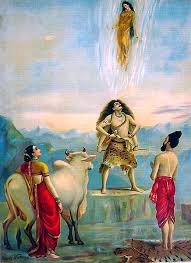The Holy River Ganges
The Ganges is the longest river in India covering 2,510 km in mountains, valleys and plains. It originates in the Gangotri Glacier of the Himalayas between snowy mountains known as the Bhagirathi River. Later, other rivers join, such as the Alaknanda, Yamuna, Sone, Gomti, Kosi and Ghaghra.
The Ganges river basin is known to be the most fertile area in the world and is the most densely inhabited and covers an area of about 1,000,000 sq km. Two dams have been built on the river, one at Haridwar and the other at Farakka. The dolphin found in the Ganges river is a threatened animal that lives exclusively in this river.
The Ganges River is considered to be the most sacred river on earth in the Hindu community. The main religious events are held in cities situated along the river, such as Varanasi, Haridwar and Allahabad. The Ganges River broadens into the beautiful forest island of Bangladesh on the Ganges delta and then completes its journey into the Bay of Bengal.

Religious significance
In India, the river Ganges is depicted as a goddess. Many holy shrines are situated on the banks of river Ganges, of which Varanasi and Haridwar are the most prominent. People worship and meditate on its ghats. The river Ganges is considered the most sacred of the sacred rivers of India and it is believed that taking bath in the Ganges lifetime sin will be finished. After death, people immerse their ashes in the Ganges to attain salvation. Even some people wish to die in the banks of the Ganges.
Mythology
According to legend, King Sagara magically acquired sixty thousand sons. One day King Sagara performed a yajna to conquer Devaloka. The horse was necessary for the yagna which jealous Indra stole. Sagara sent all his sons in search of a horse. Finally, they found the horse in Hades, which was tied to a sage. The sons of Sagara insulted the sage, thinking that the sage was the reason for the horse’s disappearance.
The sage, absorbed in penance, opened his eyes after thousands of years and by his anger, all the sixty thousand sons of Sagara were burnt there. The souls of the sons of Sagara started wandering as ghosts because they were not cremated. Sagara’s son Anshuman unsuccessfully attempted to liberate souls, and later Anshuman’s son Dileep too. Bhagiratha was the son of King Dileep’s second wife. He cremated his ancestors.
He pledged to bring the Ganges to Earth so that at his last rites, the ashes could flow into the Ganges water and wandering souls could go to heaven. Bhagiratha did austerity of Brahma to bring Ganga to earth. Brahma was pleased and agreed to send Ganga to Earth and ordered Ganga to go to Earth and then to Hades so that the souls of the sons of Sagara could be liberated. Then Ganga said that when I fall on the earth from such a height, how will the earth be able to bear so much velocity?
Then Bhagiratha pleaded with Lord Shiva, and he stopped the velocity of the Ganges in his open jatas, opening a braid, causing the incessant current of the Ganges to flow to the earth. The stream followed Bhagiratha to the Ganges Sagar Sangam, where the sons were saved. At the touch of Shiva, the Ganges became even more holy and the earth became a centre of great reverence for the people.
Pollution and the environment
The Ganges River is known worldwide due to its purification capacity. There is also a scientific basis for the recognition of its purification, which has been in practice for a long time. Scientists believe that the water in this river contains viruses called bacteriophages, which do not let bacteria and other harmful microorganisms survive. The river water has the additional capacity to retain the amount of pranavayu (oxygen). But the reason for this is still unknown. According to a national public radio program, the risk of diseases like cholera and dysentery is greatly reduced due to which the chances of getting pandemics are largely avoided.
But the pollution of the Ganges has been a matter of concern for the Government of India and the public for many years due to the presence of dense residents on the banks of the Ganges, the smell of the drains of industrial cities in the Ganges river. The abundance of industrial waste, as well as plastic waste, has also polluted the Ganges water immensely. According to scientific investigation, the biological oxygen level of Ganga has increased from 3 degrees (normal) to 6 degrees.
Twenty-nine million litres of polluted waste is falling daily in the Ganges. According to the World Bank report, 12 per cent of diseases in Uttar Pradesh are due to polluted Ganges water. It is deeply worrying that the Ganges-water is neither worthy of bathing, nor drinking, nor irrigation. The fall of the Ganges would mean the end of our entire civilization. The help of crocodiles is being taken to control the increasing pollution in the Ganges. Banks are being put in place to clean the city’s filth and to prevent the waste of industries from falling into it.
The scheme has been implemented. However, its successes are also being questioned. The public has also become aware of this topic. Besides this, efforts are also being made not to hurt religious sentiments. Despite all this, the existence of Ganga is clouded by the crisis. According to a 2007 United Nations report, the Himalayan Ganga reservoir located on the Himalayas is expected to be finished by 2030. After this, the flow of the river will be seasonal depending on the monsoon.